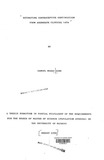| dc.description.abstract | The thesis attempts to examlne one very persistent
problem with the use of contraceptives, namely,
contraceptive continuation.
Many developing countries have launched family planning
programmes with the aim of recruiting contraceptive
acceptors not only for the purpose of limiting fertility but
also to improve the health of both the mother and the child.
These family planning programmes have indeed had a
substantial impact by way of promoting the use of modern
contraceptive methods for purposes of curbing human
fertility. Among the methods popularly used both in the
developed and developing countries are oral contraceptives,
also called pills, injectables, intrauterine devices (IUDs),
foaming tablets and jellies, cervical caps and diaphragms.
Many researches have been conducted on the continued
use of these family planning methods using diverse
approaches and the concept of continuation rate or
conversely, discontinllation rate has become associated with
many contraceptives. Contraceptive use-dynamics serve as a
major measurement of a family planning programme quality
Slnce client satisfaction with methods is reflected in
continuation rates while client skill at using methods lS
reflected in failure rates.
In any family planning programme, it would be
desirable to recruit a large v(llume of contraceptive
acceptors and that these contraceptives provide protection
against pregnancy for some considerable time of a woman's
reproductive lifetime.
This study presents a simple method of estimating
contraceptive continuation rates which applies to aggragate
programme acceptor data. The method uses counts of new and
continuing contraceptive users from a number of clinics for
every year since the clinic started operation. These data
are then fitted 1n the discrete geometric continuation
model. In order to estimate the continuation rates of pills,
IUDs and injectables, Family Planning Association of Kenya
(FPAK) data was used. To further supplement information on
continuation rates, a sample of contraceptive users was
analyzed to determine the demographic, social and economic
factors associated with- contraceptive continuation rates and
also to estimate the average duration a contraceptive method
is used by acceptors.
It 1S argued in this thesj~ that many factors interact
to influence contraceptive continuation and using the
continuation model developed by Hammerslough (1988), it is
estimated that 50 per cent, 70 per cent and 60 per cent of
pill, injectable and IUD users respectively will continue to
use these methods after one year. The procedure presented in
this study has very little data requirements and is designed
in a way that family Planning Programme administrators will find it a
tool easy to use for evaluation. | en |

